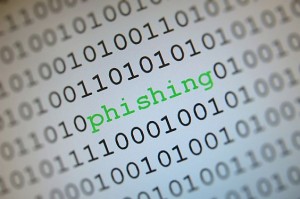Identity Theft and Phishing

Phishing is an online scam that intends to reveal personal information of its victims.
The scammers want to reveal your personal data as date of birth or credit card numbers. It can be called identity theft and may lead to run up of false credit card charges or steal of money from bank accounts. Many phishing attacks may be created to steal website passwords and logins, email or your sensitive information.
Firstly, a spam email is sent by the criminals. It is designed to look like an email from a trusted organization as a bank or some other financial company. The scammers will do their best to make the email be as from a legitimate organization or company. These emails may have a wording and similar design as official emails as well as same graphics and so on.
The message can include link to a “real” website placed on the first page. This fake can look identical or similar to the legitimate site. Getting in the phishing email you may be asked to provide your personal details.
Keylogger software can be embodied into email and spy on the keystrokes. It will relay them remotely to the criminals who can see your sensitive information as financial details or passwords that you enter.
Some of us can easily be tricked to provide our personal data. The criminals can also purchase goods and services using such victim’s personal data as drain funds from the bank accounts or financial credentials.
It is cheap to send an email that criminals send out a great number of similar emails and target customers from the particular organization such as an internet service provider or bank. Sending out such emails phishers expect that at least some of the receivers are the customers of the real organization they supposedly send emails from.
You should know how to protect yourself from online identity theft and phishing attacks.
The effectiveness of phishing emails is high because the senders try to make them look like they are from a legitimate organization or company including similar graphics, design, wording and links.
Be aware when receiving emails. No financial institution or bank will ask their customers to provide their personal information through email. Phishing emails may target your sensitive details as social security information, your date of birth or credit card number.
Bad grammar, poor spelling or an unusual turn of phrase are among evident characteristics of phishing emails. Most of emails come from countries that do not use English as their first language. Professional and accurately designed email is a sign of a reputable company that uses its best to communicate with its clients.
Phishing email may contain the information that it is something wrong with your bank account’s security and asks you to enter your personal details in order to identify you.
Some of phishing emails can appear like a warning about your undone purchase to cancel it by providing your details. Any reputable bank will hardly announce its customers about some inconveniences through email.
Phishing emails are often generally worded while any business that deals with you already knows all necessary information that is specific to you.
Be cautious if you are not sure if the email you received is from your bank or other legitimate company. Contact the organization when you doubt about the origin of the letter. Read the message attentively before reply on it or click to any embedded link.
A legitimate site of the organization is the reliable source to learn the information you doubt about.
Related posts:
» Spam, spammers and your email address….What can you do?
Leave a Reply
You must be logged in to post a comment.
 Email Addresses
Email Addresses